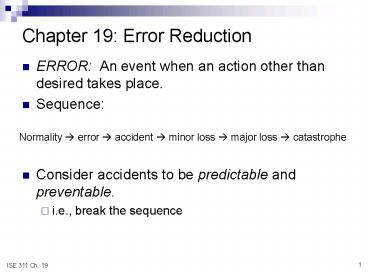Chapter 19: Error Reduction PowerPoint PPT Presentation
Title: Chapter 19: Error Reduction
1
Chapter 19 Error Reduction
- ERROR An event when an action other than
desired takes place. - Sequence
- Consider accidents to be predictable and
preventable. - i.e., break the sequence
Normality ? error ? accident ? minor loss ? major
loss ? catastrophe
2
Error reduction ? cognitive ergonomics.
- Justifications of ergonomics center around
- Reduction of physical stress
- Reduction of errors (waste)
- Benefits of reducing errors
- Improves safety
- Improves quality
- Improves productivity
3
Causes of Errors
- Poor design of equipment
- Poor management of equipment
- Poor procedures
- Poor training
- Other factors
4
Errors in the Workplace
- Costs
- Range from seconds of time to injury and death.
- Include cleanup, fines, loss of market share,
legal costs. - Are difficult to quantify.
- Are often concealed.
- Are perceived unequally.
5
Errors in the Workplace
- Reduce costs by
- Give more attention to problems where potential
cost is higher. - Be a scientist, not an advocate.
- Seek root causes, not blame.
- Avoid punishment.
6
Types of Errors
- Omission or commission
- Type 1 or Type 2
- System or measurement (of the system)
- Observed error System Measurement
- Perception, decision, or action
- Slip vs mistake
- Slip non-deliberate failure to follow rule
- Mistake
- Conscious planning results in unanticipated
action - Failure of knowledge
- Malice deliberate violation of rules or
procedures
7
Error Analysis Techniques
- Checklists
- FMEA / FMECA
- Decision structure tables
- Fish diagrams
- Fault trees
8
Making Decisions/Actions in Public
- Eliminating privacy can eliminate many errors.
- Add lighting or move objects/people to visible
places. - Require approval for deviations from policy.
- Increase the number of required decision makers.
- Decisions tend to be slower but better quality.
- Exceptions
- Emergency situations
- High risk environments
9
Guideline 1 Get Enough Information
- Generate relevant information.
- May be difficult if information is subjective.
- Provide additional information for novices.
- Ensure information reception.
- Be sure people know how to get and use
information. - Be sure novices know how to find it.
10
Guideline 2 Ensure That Information Is Understood
- Communicating with the general public is more
difficult than with employees. - For directions, use a series of signs instead of
maps. - For maps, use track up rather than north.
- Translate and standardize words.
- Avoid double negatives.
- Field-test procedures.
- Use information feedback.
11
Guideline 3 Have Proper Equipment /
Procedures / Skill
- Equipment
- Design
- Amount
- Arrangement
- Maintenance
- Procedures
- Computer procedures
- Human procedures
- Skill
- Consider skill of machine vs. person.
- Do not assume a fully capable and trained
operator. - Provide job aids and refresher training.
- Novices make more errors than experienced
operators.
12
Guideline 4 Dont Forget
- Reduce the need to remember.
- Avoid verbal orders.
- Make a list.
- Do it now.
- Have standard places for things.
- Use memory aids.
- Make them complete, convenient, and accessible.
- Use forms to indicate when information is
missing. - Consider downsides.
- Create a pattern or standard sequence.
- Use calendars, appointment cards, and reminders.
13
Guideline 5 Simplify the Task
- Improve communication.
- Field-test instructions.
- Use all-letter or all-numeric codes.
- Avoid complex words.
- Emphasize important information.
- Let the operator filter information.
14
Guideline 6 Allow Enough Time
- Too little time results in stress and errors.
- Time stress is one stress than can be reduced.
- Assign additional staff when necessary.
- Cross-train employees to provide flexibility.
15
Guideline 7 Have Sufficient Motivation
/Attention
- Motivation
- Motivation is not a substitute for engineering.
- Social pressure can help or hinder performance.
- What motivates people is not always obvious.
- Attention
- Lack of sleep and substance abuse may cause
lapses. - For critical decisions and actions, minimize
distractions.
16
Guideline 8 Give Immediate Feedback
- Calibrate instruments periodically.
- Use closed-loop systems.
- Notify the operator when an error has been
corrected. - Make error messages specific and understandable.
- Consider that operators may disable alarms.
- Reduce delay between error and detection.
17
Error Message Guidelines
- Try to reduce or eliminate the need for them.
- Be specific and precise.
- Be positive and constructive.
- Be consistent in language use and display format.
- Use user-centered phrasing.
- Test their usability.
18
Guideline 9 Improve Error Detectability
- Amplify the signal
- Match it to enable paired comparison.
- Do not contradict population stereotypes.
- Consider location and time.
- Reduce the noise.
19
Guideline 10 Minimize Consequences of
Errors
- Make important decisions or actions multi-step
and reversible. - Make equipment and procedures fail-safe.
- Consider ease of recovery.
- Ensure recovery does not cause additional
problems. - Minimize spread of the error through the system.
- Provide guards.
20
Inspection
- Can be manual, fully automatic, or semiautomatic.
- Inspect all items for one characteristic at a
time. - For searches, consider task, environment, and
personnel factors. - Train inspectors and provide an inspection
manual. - Inspection Workstations
- Consider replacing microscopes with video
cameras. - Use an appropriate colored background.
- Make chair, work surface, and lighting adjustable.

